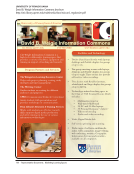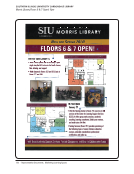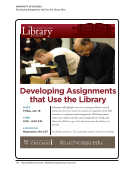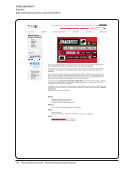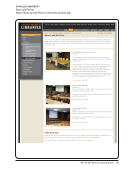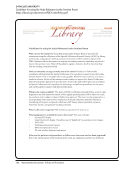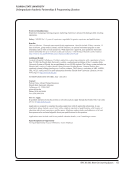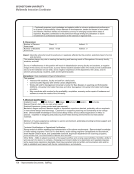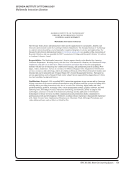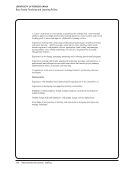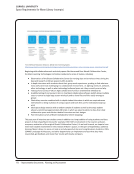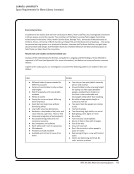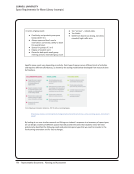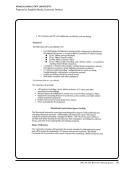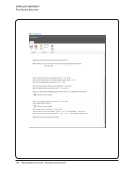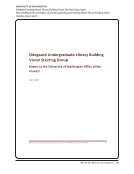70 · Survey Results: Survey Questions and Responses
25. Are you gathering any metrics that link library instruction or programming to student success in
any way? N=70
Yes 26 37%
No 44 63%
If yes, please briefly describe the metrics. N=24
A rubric is used to determine whether library instruction had any effect on learning.
As part of an IMLS Lib Val grant project metrics for value of teaching learning spaces and for instruction.
Currently involved in ACRL Assessment in Action project may lead to identifying/developing specific metrics.
Faculty evaluation of bibliographies produced before and after an instruction session.
Feedback from faculty
For at least one credit course, the instructors have polled the students 2–3 years later to measure their success.
In UNIV190L course, rubrics are used for the purpose of assessing artifacts (annotated bibliography, research journal),
indicating whether students have successfully internalized and critically applied knowledge.
Investigating National Survey of Student Engagement (NSSE) information literacy module.
iSkills is being implemented, but the usefulness of it is still in question.
Not systematically, but some librarians work closely with faculty on developing activities or curriculum-related
assignments that measure student success, quantitatively or qualitatively.
On local engagement survey, students report on frequency of visits to library and interactions with librarians.
Our libraries are engaged in Balanced Scorecard planning, and we expect this effort will help us assess the link between
instruction/programming and student success.
Pass rate in required credit course
Rubric applied to information literacy skills.
Rubrics assessing student learning outcomes for assignments, scores on information literacy tutorials and assignments,
and student perceptions of change in skill levels on information literacy outcomes.
SAILS, Freshman Composition 1120 paper source analysis via rubric. Nursing class assignment source analysis via rubric.
Student Success Programs offer programs in learning spaces.
There is much assessment of information literacy instruction, which is currently being done in the traditional
learning spaces.
We are in the early stages of a learning analytics program.
We are just beginning to gather this information, but our preliminary metrics include instructor surveys that indicate
students who have had library instruction are more successful in their assignments for that course. In addition, on
a small scale, highly successful students who receive Information Literacy Awards at the Undergraduate Research
Exhibition consistently state that library instruction, meeting with librarians, and library research guides were critical to
their success.
25. Are you gathering any metrics that link library instruction or programming to student success in
any way? N=70
Yes 26 37%
No 44 63%
If yes, please briefly describe the metrics. N=24
A rubric is used to determine whether library instruction had any effect on learning.
As part of an IMLS Lib Val grant project metrics for value of teaching learning spaces and for instruction.
Currently involved in ACRL Assessment in Action project may lead to identifying/developing specific metrics.
Faculty evaluation of bibliographies produced before and after an instruction session.
Feedback from faculty
For at least one credit course, the instructors have polled the students 2–3 years later to measure their success.
In UNIV190L course, rubrics are used for the purpose of assessing artifacts (annotated bibliography, research journal),
indicating whether students have successfully internalized and critically applied knowledge.
Investigating National Survey of Student Engagement (NSSE) information literacy module.
iSkills is being implemented, but the usefulness of it is still in question.
Not systematically, but some librarians work closely with faculty on developing activities or curriculum-related
assignments that measure student success, quantitatively or qualitatively.
On local engagement survey, students report on frequency of visits to library and interactions with librarians.
Our libraries are engaged in Balanced Scorecard planning, and we expect this effort will help us assess the link between
instruction/programming and student success.
Pass rate in required credit course
Rubric applied to information literacy skills.
Rubrics assessing student learning outcomes for assignments, scores on information literacy tutorials and assignments,
and student perceptions of change in skill levels on information literacy outcomes.
SAILS, Freshman Composition 1120 paper source analysis via rubric. Nursing class assignment source analysis via rubric.
Student Success Programs offer programs in learning spaces.
There is much assessment of information literacy instruction, which is currently being done in the traditional
learning spaces.
We are in the early stages of a learning analytics program.
We are just beginning to gather this information, but our preliminary metrics include instructor surveys that indicate
students who have had library instruction are more successful in their assignments for that course. In addition, on
a small scale, highly successful students who receive Information Literacy Awards at the Undergraduate Research
Exhibition consistently state that library instruction, meeting with librarians, and library research guides were critical to
their success.






















































































































